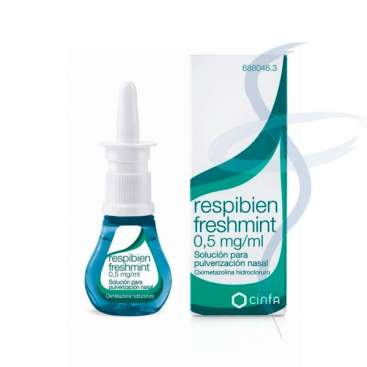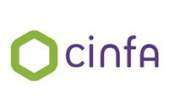Respibien Freshmint 0.5 Mg/Ml Nasal Spray Nebulizer 15 Ml
Oxymetazoline. Decongestant, indicated for local and temporary relief of nasal congestion in adults, adolescents and children over 6 years of age. Mint scent.
Oxymetazoline. Decongestant, indicated for local and temporary relief of nasal congestion in adults, adolescents and children over 6 years of age. Mint scent.
Respibien Freshmint 0.5 Mg/Ml Nasal Spray Nebulizer 15 Ml (English)
Blocked Nose Relief Oxymetazoline Hydrochloride
You can buy Respibien Freshmint Nasal Spray online from UK, Austria, Belgium, Cyprus, Estonia, Finland, France, Germany, Greece, Ireland, Italy, Latvia, Lithuania, Luxembourg, Malta, the Netherlands, Portugal, Slovakia and Slovenia.
ACTION AND MECHANISM
- [NASO / FARINGEO DECONGESTIONANT], [ADRENERGIC AGONIST (ALPHA-2)]. Oxymetazoline is an imidazole derivative of clonidine with alpha agonist activity. Its pharmacology is not well established, but its topical vasoconstrictive effects appear to be due to binding to postsynaptic alpha-2 receptors, although certain alpha-1 effects can not be ruled out. After its topical administration it causes a vasoconstriction of the capillaries of the mucosa, decreasing the blood content and the swelling of the mucosa, which produces a decongestant effect of the nasal passages.
The decongestant effects of oxymetazoline are more durable than those of alpha-1 agonists, such as phenylephrine, although they are slower.
PHARMACOKINETICS
Nasal route:
- Absorption: There have been many pharmacokinetic studies with oxymetazoline. It has been found that this drug could be absorbed after nasal administration. The decongestant effects appear after 5-10 minutes, being maximum after 6 hours. Its vasoconstrictor activity can be prolonged up to 12 hours.
- Elimination: The oxymetazoline is eliminated by urine, appearing 30% of the unaltered dose after 72 hours. It also presents some elimination by feces (10%). Its elimination half-life is 5-8 hours.
INDICATIONS
- [NASAL CONGESTION]. Symptomatic treatment of local and temporal nasal congestion.
POSOLOGY
- Adults and children from 6 years old, nasal:
A nebulization in each nostril every 10-12 hours, maximum two applications per day.
- Children under 6 years: The safety and efficacy of this medicine has not been evaluated.
RULES FOR THE CORRECT ADMINISTRATION
It is recommended to administer this medication in the morning and in the evening, avoiding treatments longer than 3 days in a row to avoid the appearance of rebound congestion, which is usually translated by the patient as an absence of effects, which entails a new administration, with the risk of overdose.
Before each administration, it is necessary to clean the nasal passages.
The valve of the container will be introduced into the nostrils, in a vertical position. Operate the valve, simultaneously performing a deep inspiration to facilitate the maximum penetration of the medication. Each press must be brief, that is, the time required to press fully and then release.
Once the medicine is administered, the end of the valve will be cleaned with hot water, drying it with a clean cloth.
Nasal spray: If it is the first time this product is used or has not been used for some time, it is necessary to charge the spray. To do this, keeping the container away from the body, press the spray down several times until a finely powdered liquid comes out.
CONTRAINDICATIONS
- Hypersensitivity to any component of the medication.
PRECAUTIONS
- Patients in whom sympathetic stimulation could worsen their pathologies. Oximetazoline administered nasally does not theoretically present a risk for these patients, although a systemic absorption can not be ruled out. Even in the case of such absorption, the effects on presynaptic alpha-2 receptors would theoretically predominate, with the consequent sympatholytic effects. However, it can not be ruled out that this drug also has affinity for other adrenergic receptors, both alpha-1 and beta receptors, so most authors recommend extreme precautions in case of diseases such as [DIABETES], [ GLAUCOMA], [CARDIOPATIA] ([CORONARY INSUFFICIENCY], [CARDIOPATIA ISQUEMICA]), [CARDIAC ARRHYTHM], [ARTERIAL HYPERTENSION], [HYPERTHROIDISM], [FEOCROMOCYTOMA] or [PROSTATIC HYPERPLASIA].
- Rebound congestion. The administration of topical vasoconstrictors often results in rebound congestion, which is usually accompanied by a new dosage by the patient. This can pose a risk of overdose, as well as an enhancement of congestion. It is recommended to stop the administration of oxymetazoline gradually in case of rebound congestion, alternating the doses in each nostril, until a definitive suppression.
WARNINGS ON EXCIPIENTS:
- By containing benzalkonium chloride can cause inflammation of the nasal mucosa, especially in long-term treatments. If persistent nasal congestion is suspected, whenever possible, a nasal product that does not contain this preservative should be used.
PATIENT TIPS
PATIENT TIPS:
- The nose should be cleaned before each application.
- It is advisable to have a correct nasal and applicator hygiene.
- It is recommended not to exceed the recommended daily doses or use for more than three days in a row to avoid rebound congestion.
- Treatment should be discontinued and the doctor should be consulted if the symptoms persist, worsen or if high fever, dizziness, insomnia or nervousness appear.
- It is common the appearance of a sensation of itching or nasal discomfort after the application, which disappears after several doses.
INTERACTIONS
No drug interactions have been described with oxymetazoline administered nasally, although this drug could present an absorption through the nasal mucosa or by ingestion of the product. There is some controversy about the effects of alpha-2 vasoconstrictors, since affinity for presynaptic receptors would predominate at the systemic level, with sympatholytic effects appearing. Despite this, and due to the possibility that this drug also acts on other adrenergic receptors, prudence advises to take precautions when they are administered together with drugs such as MAOI antidepressants or tricyclic antidepressants, with antihypertensive drugs such as diuretics, beta-blockers, methyl-dopa or guanethidine, with thyroid hormones, with nerve stimulants, nitrates or with digoxin.
PREGNANCY
Category C of the FDA. No animal studies have been conducted, although other sympathomimetic amines have given rise to teratogenic effects in some species. There are no adequate and well-controlled studies in humans, so it is unknown whether the nasal application of oxymetazoline could lead to adverse effects, although possible systemic absorption should be taken into account. The use of this medicine is only accepted in case of absence of safer therapeutic alternatives, and limiting its use to short periods of time.
LACTATION
It is not known if oxymetazoline is excreted in breast milk, and its possible effects on newborns. Taking into account that systemic absorption is possible, and since young children are especially sensitive to the adverse effects of sympathomimetic amines, it is recommended to stop breastfeeding or avoid administration of this medication.
CHILDREN
Safety and efficacy in children under 6 years of age have not been evaluated, so its use is not recommended. In children, the appearance of adverse reactions of the type of sedation is more common, which can be serious and require supportive treatment.
ELDERLY
Elderly patients are more susceptible to presenting adverse reactions after the use of sympathomimetics. They can also suffer from pathologies that could be worsened by the administration of sympathomimetics, as well as being treated with drugs with which this active ingredient could interact. Close monitoring of patients over 60 years of age is recommended, and treatment should be discontinued at the least indication of significant adverse reactions. A dose readjustment may be necessary.
EFFECTS ON DRIVING
Oxymetazoline can lead to sedation, substantially affecting the ability to drive and / or operate machinery. Patients should avoid handling dangerous machinery, including automobiles, until they have reasonable assurance that drug treatment does not adversely affect them.
ADVERSE REACTIONS
The side effects of this medication are usually local and mild. However, a systemic absorption of this drug can not be ruled out, with the appearance of systemic adverse effects, which can increase in intensity and severity at higher doses. The most frequent alterations are:
- Local effects: The appearance of [SCORNUDES], [NASAL IRRITATION], sensation of itching and local burning, [NASAL DRYING] or [RINORREA] is common. It is also frequent the appearance of [NASAL CONGESTION] rebound, especially in case of high doses or after prolonged periods of time. In case of abuse of the drug may appear [RHINITIS], appearing the edematous mucosa and with a reddish or pale gray color. These signs usually disappear after a week of medication suspension.
- Systemic effects: The absorption of oxymetazoline can lead to [MAREO], [VERTIGO], [NAUSEAS], [VOMITOS], [NERVIOSISMO], [PALPITACIONES], [ARTERIAL HYPERTENSION], [BRADICARDIA] reflects, [EXCESS SWEATING] or [PALITY]. In children, it can cause [SOMNOLENCE].
OVERDOSE
Symptoms: There is not much experience with dosing with oxymetazoline, since acute overdosing is not frequent due to the administration form. In case of accidental ingestion of other drugs such as nafazolin, it is common the appearance of nervous depression, with sedation, intense hypothermia, bradycardia and in severe situations, coma. This overdose is especially important in children. There may also be headache, tremor, palpitations, nervousness or excessive sweating. The LD50 is 10 mg in children aged 2 years, and about 100 mg in adults.
Treatment: After the ingestion, it is recommended to proceed with the elimination of the drug by gastric lavage and administration of activated charcoal every 4-6 hours. In early stages, emetics and saline laxatives can be administered. However, these measures do not seem to be very effective, since sedation appears quickly.
The treatment must be symptomatic and supportive. If seizures appear, diazepam will be administered. The administration of vasopressors should be avoided if the patient has hypotension. It is recommended to monitor cardiac functionality and vital signs.
See leaflet Respibien Freshmint 0.5 Mg / Ml Nasal Nebulizer 15 Ml
See Technical Data Sheet Freshmint 0.5 Mg / Ml Nasal Nebulizer 15 Ml
Antonio L. published the 11/10/2023 following an order made on 23/09/2023
Veramente buono e non irrito i turbinati
Henrique F. published the 24/08/2023 following an order made on 07/08/2023
Producto muy bueno pero que se se no vende en Portugal Intentalo de venderlo aqui. Será mucho más comodo!!!




